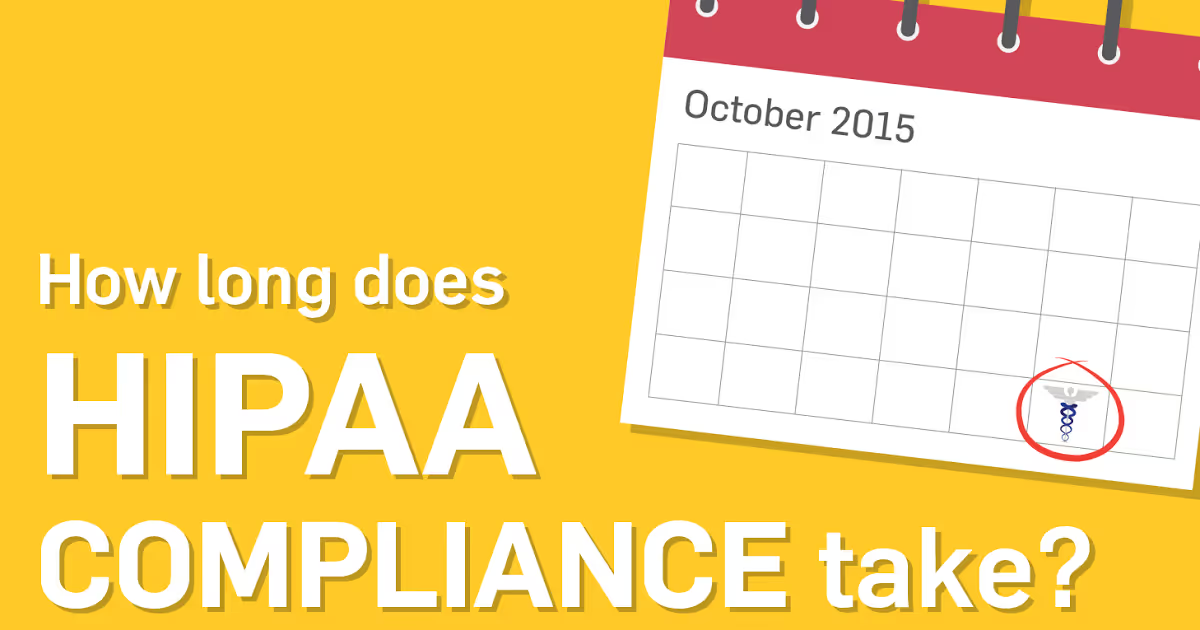HIPAA compliance is a process, not a destination . . . but it doesn’t hurt to know your timeframe.

HIPAA compliance is a process, not a destination . . . but it doesn’t hurt to know your timeframe.
HIPAA, or the Health Insurance Portability and Accountability Act, is a set of guidelines created by the U.S. Department of Health and Human Services (HHS) and enforced by the Office for Civil Rights (OCR) through HIPAA audits. The reason it exists is to ensure the confidentiality, integrity, and availability of patient information, both physical and electronic.
See also: How Healthcare Security Complacency is Killing Your Organization
I’ll try to cover the "what is HIPAA compliance" basics and not overwhelm you. If you want to learn more, you’ll see lots of external links to places that cover certain topics more in depth (like these useful HIPAA FAQ and HIPAA Myths articles).
See also: Snapshot of HIPAA and Healthcare Data Security
HIPAA rules apply to two groups: covered entities and business associates.
Ultimately, anyone who accesses PHI is responsible for upholding HIPAA compliance requirements. Individuals and companies can independently face criminal charges for mishandling patient health information. After all, you have a responsibility to patients.
Learn more in depth who is responsible for HIPAA violations.
In HIPAA, the OCR audit protocols are composed of the Privacy Rule, the Breach Notification Rule, and the Security Rule. Most healthcare organizations are already pretty familiar with the first two, so I generally focus on the Security Rule when discussing HIPAA compliance timeframes.
The HIPAA security challenge for most entities is technology and the fact that PHI is literally everywhere. Since the rise of electronic record implementation, it’s become more difficult to secure patient data from breach exposure. With each new mobile device, networked medical device, and computer come additional unsecured avenues to patient data.
The Security Rule shows certain requirements be met to safeguard patient data. For example: encrypting emails, logging off computers when leaving workstations, securing data backup, signing new business associate agreements, implementing risk management plans, conducting a risk analysis, enforcing security policies, and regular employee trainings.
All in all, there are 77 Security Rule requirements that encompass 254 individual validation points.
Learn more about your HIPAA security requirements.
See also: SecurityMetrics HIPAA Guide
During a recent webinar, a rather persistent attendee asked, “I understand I have to do it, but how long does HIPAA compliance take?” Unfortunately for that webinar attendee, the answer to his question isn’t simple.
I can’t accurately determine how long without a full assessment of an individual organization’s systems, workforce, and technology. And even then, the timeframe simply depends on too many variables.
Before I review those variables, let me make one thing very clear. HIPAA is not a destination, it’s a journey.
HIPAA compliance and HIPAA security are never 100% complete. Medical processes are always changing, workforce member turnover happens, technology is updated, and before you know it, the environment is significantly different from its last HIPAA assessment. My point is, HIPAA should be an ongoing ‘business as usual’ practice.
That being said, I know you’re still probably looking for a timeframe. So, let me try to estimate for you.
See also: How Much Does HIPAA Compliance Cost?
Expect HIPAA to be a full-time job for an entire team of healthcare risk and compliance professionals. If you’re starting from scratch, HIPAA compliance will likely take you 2-3 years (if not more).
Does that seem like a ridiculous estimate? First, think of how long it’s taken your employees to get up to speed with the HIPAA Privacy Rule. Now double that.
The Security Rule contains 77 requirements (three more than the Privacy Rule). Those 77 requirements have 254 validation points. Each of those validation points requires a big change in technology or process for your organization’s infrastructure. Not to mention the giant list of all business associates you’re required to monitor for HIPAA compliance as well.
The point is healthcare organizations don’t already have the infrastructure to support HIPAA’s strict security requirements regarding patient data security. It’s not just processes and trainings that need to occur. HIPAA may require an entire systems overhaul within your organization.
Because each large environment is unique, I highly recommend speaking with a HIPAA consultant who can break down what is expected of your organization and get you on a plan to HIPAA success.
Medium-sized organizations are difficult to estimate, because they vary so much in size. But generally, from beginning to end, HIPAA will likely take you 1-2 years.
Because medium-sized entities usually have multiple locations, start a PHI flow chart to speed up your process. This helps identify exactly where your PHI is, where it flows, and where it’s stored to assist in your decision to implement appropriate patient data safeguards.
With a full-time staff member devoted to HIPAA, it should take a typical office less than 6 months to become compliant. If a full-time employee isn’t realistic, or if you can only afford a few hours per week, HIPAA compliance will take longer.
Lucky for you, requirements that may take a large organization years to accomplish, you can finish in half the time (e.g., business associate agreements, risk analysis, risk management plans, etc.).
Check out this this 21-day plan for HIPAA compliance
Start now or risk spending even more time on HIPAAWhat is HIPAA compliance? It’s the best and only government-sanctioned way to secure your patients’ sensitive medical data. It’s a necessary evil…that shouldn’t be considered evil. It’s expected.
HIPAA is not going away. In fact, I estimate that the HHS will release an updated version in the next few years.
I don’t mean to depress you with these timeframes. I hope they give you a realistic expectation for what is truly required for HIPAA compliance.
If you’re not sure where to start, check out this awesome software designed to track HIPAA progress. Get a free demo here.